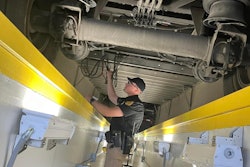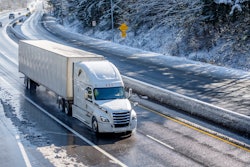Speaker 1:
CCJs 10 44 is brought to you by Chevron Delo, heavy duty diesel engine oil. Now there's even more reasons to choose Delo. Are your Trailer Underride safe? We talked this week with one safety advocate that thinks they're probably not. You're watching CCJs 10 44, a weekly episode that brings you the latest trucking industry news and updates from the editors of CCJ. Don't forget to subscribe and hit the bell for notifications so you'll never miss an installment of 10 44. Hey everybody, welcome back. I'm Jason Cannon and my co-host. On the other side is Matt Cole Wabash. Last month was hammered in a nearly half a billion dollar lawsuit that found its underride bumper. Didn't do enough to prevent vehicle underride in a 2019 fatality in St. Louis, even though it met the NISA standard at the time.
Speaker 2:
Maryanne Karth has emerged as a leading advocate for underride protection and she believes standards should be focused on preventing UNDERRIDE at the highest possible speed.
Speaker 3:
When we drafted the Stop Underwriters Bill, we put into their research to find out what is the outer limits of survivable underwriting protection, and that research got into the bipartisan infrastructure bill in 2021 and a contract was given to a company to do that research, and I'm waiting for that final report to be published on that. They were to be testing at 40, 45 and 65. The point wouldn't be that it would necessarily be survival six five, but when you have your blood pressure taken and for example mine, they pump away up to 200 and then go down, down, down, down, down, and mine is like one 15 to one 20, maybe one 30 sometimes, but they don't want to miss the top right. So that's kind of the principle of that. So hopefully this research will answer some of those questions for us. The thing about underride protection is that what it does is it makes the crashworthy features of the passenger vehicle able to work when there's, there's a collision between a passenger vehicle and a large truck because of the geometric mismatch where the bottom of the truck is up higher than the bumper of the passenger vehicle.
Then if there's a two week rear guard that gives wave when the car hits so that it moves out of the way, comes off, like in our case it came right off the truck so that the first point of impact would be the windshield, the E pillar in that can't stop a truck from coming into the survival space of the occupants. So that research that I was talking about is going to be looking at the highest speed and whether those are survivable crashes. The crash worthy features on passeng vehicles like bumpers, crumple zones, airbag, seatbelt, tensioners, they don't work the way they're supposed to when there's an underride crash.
Speaker 1:
As Marianne just mentioned, she has firsthand experience with trailer underride. Her car in 2013 was struck by a different truck, sending her car backwards into the rear of a trailer and tragically killing her two daughters.
Speaker 3:
The second truck involved in our crash was changing lanes and hit us. So it spun us around, as you said. So we went backwards into the back of another tractor trailer because if it had been like a lot of rear under rides are, and I had been going forward, then I would not be here talking to you today. I would be dead instead of my daughters who the back of our car went under and they were sitting in the backseat. But in fact, there are many different scenarios of crashes and the point is that the guards have been proven by the Insurance Institute for Highway Safety to have been too weak. Our family has been advocating for stronger Android protection for 11 years now, and we've been taking a multi-pronged approach. In fact, even before we did our online petition asking DOT to improve the rear guard rule as well as side guards in front, and my husband Jerry sent out letters to the trailer manufacturers asking them to improve their guards because a couple of months before our crash, the Insurance Institute for Highway Safety had published a report from their several years of crash testing where they had proven that the eight major trailer manufacturers had guards that were too weak even though they met the federal standard.
But two months before a crash, the report indicated that one of those trailer manufacturers had redesigned their guard and were successfully crash tested all across the back of the trailer, even at the 30% office at the outer edges, and that was the man from Canada, which when we learned that engineers could have designed a stronger rear guard that would've been on the truck that we collided with and that our daughters could have been alive because of that. I dunno if you can understand how frustrating that would be. And so not only did Jerry w write to the trail manufacturers, but he also wrote to a hundred trucking companies alerting them to that information and asking them when they bought new trailers to make sure that they were stronger trailers.
Speaker 2:
Part of the frustration safety groups and Marianne in particular have with the trucking industry is that she sees the NITSA standard for trailer underride as the low bar, and there's nothing stopping fleets and manufacturers from clearing it to a higher standard.
Speaker 3:
The other thing that is a of federal regulations is that their minimum standards and they encourage the manufacturers to go beyond that. That's another thing that manufacturers should be well aware of. And if they know that there's stronger protection available or technologically possible, then who's responsible? Who should be liable for putting safer products on the road?
Speaker 1:
Now, Marianne's case is unique in that she was basically shoved into the underride bumper, which was snapped off at impact, but most underride crashes or passenger cars simply rear ending a stopped or a nearly stopped trailer. Marianne says she's not at all interested in who's at fault. She's after saving lives.
Speaker 3:
Why are we focusing on the cause of the crash? And should somebody, because they've made a mistake when some piece of equipment could be on the truck to prevent it, should they pay for the mistake with a death sentence
Speaker 2:
Every time there's an underride fatality? Marianne said, fleet should take note that the underride protection on their trailers might not do what it's designed to do. What the Wabash case in St. Louis did was shine a spotlight on it because a more than $400 million jury award has a way of getting your attention more on that after a quick word from 10 44 sponsor schon lubricants,
Speaker 4:
We serve customers from Birmingham, Alabama to the Gulf Coast, so our people and our trucks are booked solid all day. There is no slack in our schedules. These trucks can't break breakdown. I choose an engine oil that takes care of the number one issue with our engines emissions, so we don't have to worry about DPF clotting. I choose the engine oil that keeps our trucks hauling. I choose delo 600 A DF.
Speaker 3:
The Wabash case showed that knowing that stronger protection is possible and is available puts manufacturers and trucking companies at risk if they continue to not equip their fleet with stronger protection. If there's a crash, then they put themselves at risk of liability in our case, and we think it's a win-win for everybody, not just for the victims. What I would like fleet managers to know is that when they're making decisions about their fleet, that there are options available to them to purchase when they purchase new trailers, to make sure it does have a tough guard and to consider doing what you said to over time update their fleet. There are retrofit kits available. Almost every trailer manufacturer that has a tough guard has a retrofit kit that you can get to update your rear guard. There's also an aftermarket retrofit kit available that is called Safety Skirt. It's an aluminum triangle that could be put on both sides. It strengthens it and brings it up to tough guard level. We've worked with that engineer and I witnessed in person a crash test in 2020 that stopped underwrite at the outer edges at 39 miles per hour. So there are solutions available.
Speaker 1:
Maryanne mentioned earlier that she's waiting on the results of a study that could ultimately determine the maximum survivable speed for an UNDERRIDE crash, but there's no guarantees that F-M-C-S-A will make any changes based on that report. In 2022, the agency upped its underride standards to prevent underride at 35 miles an hour up from 30 miles an hour changing them so soon seems like a big ask, but that report, Marianne said, should give fleets and manufacturers the kind of data they need to improve underride protection irrespective of what the government might do.
Speaker 3:
The whole IHS testing and tough guard award situation is a good example. When the trailer manufacturers found out how they did on the crash testing, they voluntarily worked on a new design and improved it to, and they all met that new, it wasn't not the standard, but they all met that new IHS calls the test protocol, and except for two of the manufacturers started offering it a standard so they could do the same thing. In fact, I know at least one manufacturer, and I don't know which one it is, but I know at least one of the manufacturers is convinced that would be effective at higher than 35 miles per hour, so they just haven't been tested officially,
Speaker 2:
Marianne noted that she didn't see the eye-popping award against Wabash as a frivolous lawsuit, and she's not necessarily happy that her push to improve Underride has found its way to the courtroom by way of nuclear verdicts. But if that's what it takes to improve underride protection industry-wide, so be it.
Speaker 3:
You don't get to choose whether you collide with a truck with a tough guard or not. We don't put good brakes on just some trucks because only some trucks might be hit or we don't have people wear seat belts just in the cards that are going to be in an accident. We put it on everything.
Speaker 1:
That's it for this week's 10 44. You can read more on ccj digital.com. While you're there, sign up for our newsletter and stay up to date on the latest in trucking industry news and trends. If you have any questions or feedback, please let us know in the comments below. Don't forget to subscribe and hit the bell for notifications so you can catch us again next week.










